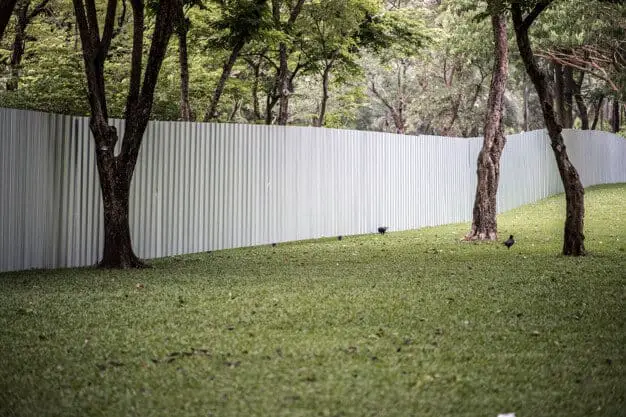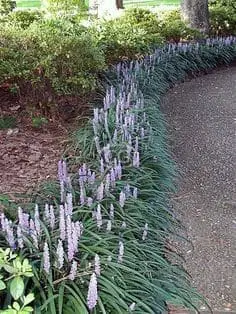Having a perfectly manicured lawn is the dream for most people but what happens when the grass on your lawn grows under the fence and into your neighbors compound? I’ll tell you what, it becomes a nightmare. In this article, I’ll explain several ways in which you could prevent grass from growing under your fence because we know how hard it is to maintain grass when it grows along those areas. So keep reading. It’s fun, I promise.

Make Use of Bricks to Create a Fence Border
The first method involves you making use of bricks to keep those edges looking tidy. Other materials you’ll need include some strings, a hand trowel, some stakes, a square point shovel, a rubber mallet, a brick chisel, a level, a hammer, and finally, a tape measure.
Measure the length of your bricks using the tape measure. Your measurement will determine the number of stakes that you’ll need. Set your stakes on both sides of the fence and spaced apart in such a way that a string tied to two adjacent stakes remains taut.
You should note that how you place your stakes depends on your type of fence. For instance, for regular fences that have the same front and back look, you’ll have to set your stakes equidistant from the fence on both sides at half the brick’s length.
While for fences that have flat fronts and back posts, you’ll have to do the following; using your tape measure, have it grip the backside of the post, set a stake at a distance of the length of one brick from the back post of the fence, repeat this process and ensure that the stakes align.
Once the stakes have been set, it is time to tie the strings to the stakes. Afterward, dig a trench using the square point shovel that you have. The trench should be as deep as the height of the bricks so they can be laid easily under the fence.
Next, we level the trench by using a hand trowel and level. If the tench isn’t leveled enough we remove some more dirt till it is. It is now time to lay the bricks but if you have a fence with back posts, you might need to use smaller bricks. Therefore to reduce the size of the ones that you’ve got simply make use of a hammer and brick chisel to hammer away the unnecessary parts.
After laying the bricks between the strings, use your rubber mallet to tap the bricks to further push them into the ground. Any extra gaps should be filled with dirt so the bricks do not move out of place. Voila, you’re done. You’d realize that when you want to trim grass around the fence with your lawnmower, all you have to do is roll its wheels on the bricks.
Good to Read : Fast Growing Hedges For Privacy Purpose
Plant Liriope Muscari Instead

If the brick border seems like too much work for you to do or if you feel that it ruins the aesthetic of your lawn then a little planting is in order.
A border of Liriope Muscari, aka Blue Lily Turf or Monkey grass, is all you need. It is an attractive foliage that looks better than overgrown lawn grass. It is a very low-maintenance plant that does not have to be mowed and it is very suitable for borders.
Here’s some basic information about the Blue Lily Turf before you go ahead to plant it.
- It closely resembles the grape hyacinth plant.
- It is native to several Asian countries such as China and Japan.
- It is made up of a dense clump of very dark green leaves, however, during the fall season and late summer, small violet-purple flowers begin to bloom and over time, these blooms become black berries during the winter.
- This plant has won an Award of Garden Merit. It’s a prestigious award doles out by the Royal Horticultural Society.
- It has to be grown in acidic soil with a pH ranging between 6.0 and 6.8.
- It grows in USDA hardiness zones 5, 6, 7, 8, 9, and 10 but may not survive through the winter seasons if grown in zone 5.
- It also prefers well-drained fertile soil for optimum growth.
- It prefers partial to full exposure to sunlight.
- It grows between 12 inches and 18 inches tall.
Now that the basic information has been cleared out of the way, you’ll need the following materials to plant the Liriope Muscari; a shovel, some compost, a tape measure, and pruning shears.
Using your measuring tape, measure the length of your fence, as this will help determine how many plants you’ll need. The spacing requirements for the Blue Lily Turf is to plant them a foot apart or according to the spacing directions they come with.
Next, we prep this soil. Prepping includes tilling the soil around the fence, so it is loose and well-aerated for planting the Liriope Muscati, adding some compost, and finally ensuring that the soil has the right pH. The soil should be tilled about 6 inches deep. Then you must mix in the finished compost so the soil becomes fertile and rich in organic matter. To make the soil slightly more acidic, simply mix in some lime juice with the soil and measure the pH using a soil test kit.
If you’ve got any mature Blue Lily Turf plants, simply divide them and plant as they’ll keep producing more crowns that way. To do this, simply dig the mature plant out carefully ensuring that its roots don’t get damaged. Then you rinse off the excess soil from the roots.
Next, using a knife, divide the roots. Plant eat division in the holes that you’ve dug and ensure that you do not bury the root crown. Water your plant and there you have it, a Liriope Muscati fence border.
With these two steps above you no longer have to worry about how your fences loo or if your neighbors are coming for you.
Want to know more about gardening ?
Fill in your email address in the form below and you'll receive all the latest updates directly in your in-box.
Thank you for subscribing.
Something went wrong.